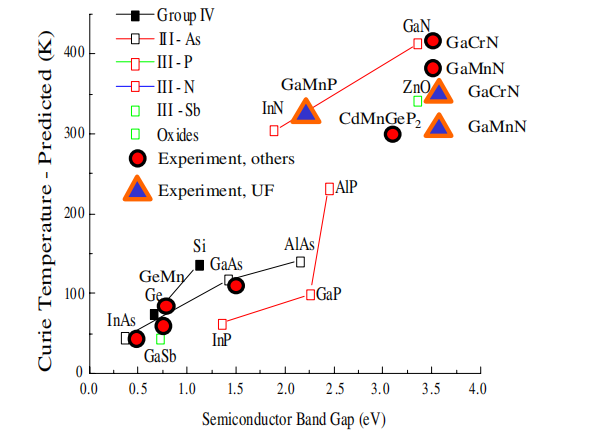Recent results on achieving ferromagnetism in transition-metal-doped GaN, AlN and related materials are discussed. The fifield of semiconductor spintronics seeks to exploit the spin of charge carriers in new generations of transistors, lasers and integrated magnetic sensors. There is strong potential for new classes of ultra-low-power, high speed memory, logic and photonic devices based on spintronics. The utility of such devices depends on the availability of materials with practical magnetic ordering temperatures and most theories predict that the Curie temperature will be a strong function of bandgap. We discuss the current state-of-the-art in producing room temperature ferromagnetism in GaN-based materials, the origins of the magnetism and its potential applications.
There are two major criteria for selecting the most promising materials for semiconductor spintronics. First, the ferromagnetism should be retained to practical temperatures (i.e. >300 K). Second, it would be a major advantage if there were already an existing technology base for the material in other applications. Most of the work in the past has focused on (Ga, Mn)As and (In,Mn)As. There are indeed major markets for their host materials in infrared light-emitting diodes and lasers and high speed digital electronics (GaAs) and magnetic sensors (InAs). In single-phase samples carefully grown by molecular beam epitaxy (MBE), the highest Curie temperatures reported are 110 K for (Ga, Mn)As and ∼35 K for (In, Mn)As as one of the most effective methods for investigating spin-polarized transport is by monitoring the polarized electroluminescence output from a quantum-well light-emitting diode into which the spin current is injected. Quantum selection rules relating the initial carrier spin polarization and the subsequent polarized optical output can provide a quantitative measure of the injection effificiency.
There are a number of essential requirements for achieving practical spintronic devices in addition to the effificient electrical injection of spin-polarized carriers. These include the ability to transport the carriers with high transmission effificiency within the host semiconductor or conducting oxide, the ability to detect or collect the spin-polarized carriers and to be able to control the transport through external means such as biasing of a gate contact on a transistor structure.

Fig1
In epitaxial GaN layers grown on sapphire substrates and then subjected to solid state diffusion of Mn at temperatures from 250 to 800 ℃ for various periods, clear signatures of room temperature ferromagnetism were observed. An anomalous Hall effect was observed at 323 K. The Curie temperature was found to be in the range 220–370 K, depending on the diffusion conditions. The use of ion implantation to introduce the Mn produced lower magnetic ordering temperatures.
There is clearly a need to examine the properties of (Ga, Mn)N with and without second phases, at least as detected by common analysis methods such as x-ray diffraction (XRD). The magnetic properties of (Ga, Mn)N grown by MBE in our group with a broad range of Mn concentrations (5 or 50 at.%) and which exhibited either one phase or multiple phases were examined. The fifirst sample had a Mn concentration of ∼5 at.% as determined by both Auger electron spectroscopy and Rutherford backscattering. The growth conditions (temperature, rate and V/III ratio) were optimized to produce single-phase material. The second sample also had a Mn concentration of ∼5 at.%, but was grown under conditions where we observe second phases. The third sample had a Mn concentration of ∼50 at.% and was designed to contain large concentrations of second phases.
上一篇: 沉积温度对多晶硅特性影响的表征